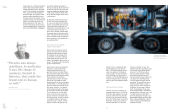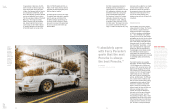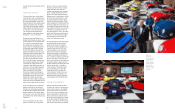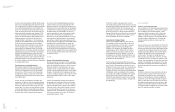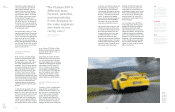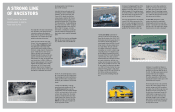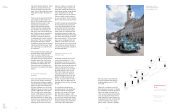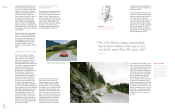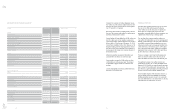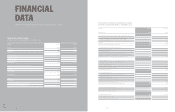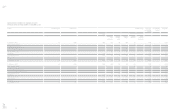Porsche 2014 Annual Report Download - page 51
Download and view the complete annual report
Please find page 51 of the 2014 Porsche annual report below. You can navigate through the pages in the report by either clicking on the pages listed below, or by using the keyword search tool below to find specific information within the annual report.
098 099
Annual Report
Porsche AG
2014
Tradition
and Emotion
The GT4 was created in Weissach. The
same place where pure racers like the
LMP1 prototype 919 Hybrid were con-
structed. “Types such as the Cayman R
and Cayman GTS come from production
and have another objective. The Cayman
GT4 is dierent: more focused, stronger,
uncompromising,” Preuninger says.“It
was designed by the same engineers who
work on our racer cars. You can see it in
the Cayman GT4: it’s a purist vehicle with
a racing soul. Ready for the racetrack and
at the same time an emotional highlight
on winding country roads.”
The Cayman GT4 is a driver’s car, a mes-
sage to the global Porsche GT community
of amateur and pro racers who use their
own cars on the race track. Reliability was
always one of the Porsche GT models’
trump cards: “The cars are driven hard.
And they take the punishment,” Preuninger
says. The new GT4 and its 385 hp top out
at 295 km/h. No Cayman has ever been
quicker or more powerful.
GROUNDED IN PORSCHE’S
GT TRADITION
At the same time, it is building bridges
between the traditional and the modern.
Like the legendary “Nr. 1” from 1948,
the engine on the Cayman GT4 is placed
at its centre, behind the backs of the
passengers. That rst Porsche eventually
led to mass production, with the fast and
light 356 becoming the rst represen-
tative of the GT family: the 356 A 1500
GS Carrera “Grand Tourisme.” With the
domesticated four-cam engine from the
550 Spyder that had claimed victory in the
Carrera Panamericana, the 356 A Carrera GT
was more race car than passenger vehicle.
As the first GT, it hardened the bond
between the race course and daily life,
a bond that had been in place for almost
60 years.
In 1999, Porsche released the 911 GT3,
which ultimately dened an entirely new
genre of car. Across years and series, the
GT3 model has become a term and brand
entirely its own, the market leader in a
segment that, now in its 5th generation,
continues to rise in popularity. With each
new 911 generation, the share of units for
this sportiest of all 911 variants continues
GT3’s style, as do the 20-inch wheels. The
rear lights glow in a special dark cherry
red, while the inside is dominated by a
minimalist style. Pull handles in the same
color as the vehicle itself are used to open
the doors – reminiscent of earlier sports
models. The volumes of the luggage
space in the front and rear have both not
been reduced by a litre, the exibility is
still retained. The Cayman GT4 is pure
reason and pure seduction all at once.
“We could have made it even faster, with
300 km/h no problem at all from a tech-
nical standpoint. But the balance between
the cw value and downforce must also
be optimal, and the extra 5km/h were
essentially meaningless.” The well-in-
formed Porsche GT customer base,
Preuninger says, understands the benets
of the mid-engine placement. “The pilot is
extremely involved in the driving. For this
reason the Cayman GT4 also only comes
with a six-gear manual transmission.
Absolutely, the PDK shifts quicker, but
is also heavier and more complex. The
control system on the transmission can
be deactivated in stages, but the Porsche
Active Suspension Management is stand-
ard – the mix of price, performance and
emotion is perfect. The Cayman GT4 is
unmatched in its market segment,” says
Andreas Preuninger.
Less is not always more. The PCPB ce-
ramic braking system and the Clubsport
package with roll cage, re extinguisher
and full bucket seats made of light,
carbon reinforced plastic and a six-point
safety belt are optional. The Cayman GT4
is unlike any Porsche that came before it,
but it is also undeniably a Porsche. “7.40
minutes for a lap on the North Loop of the
Nürburgring – that’s the gold standard for
its class. The little guy has gotten mighty
big,” says Andreas Preuninger with sat-
isfaction. Or in other words: the Cayman
GT4 is a real Porsche.
“ The Cayman GT4 is
different: more
focused, powerful,
uncompromising.
It was designed by
the same engineers
who work on our
racing cars.”
ANDREAS PREUNINGER
Director GT product line
Drive
3.8 l, six cylinders taken from
the 911 Carrera S, with 385 hp
(283 kW) and enhanced six-speed
manual transmission: zero to
100 km/h in 4.4 seconds, top
speed 295 km/h. Dynamic power
reserves for all challenges on the
course.
Aerodynamics
The first Cayman with downforce:
front spoiler and fixed rear wing
generate downforce on the front
and rear axles. As such, the
Cayman GT4 offers even greater
driving stability and extraordinary
performance through curves.
Chassis
World-class technology: chassis
and braking system originate
primarily from the 911 GT3. Active
PASM dampening system and
dynamic gearbox bearing designed
for motorsports-style driving.
Racetrack
DNA: the
rear wing on
the Cayman
GT4 can be
adjusted
for dierent
situations.
to rise. The new GTS RS, with a 500-hp,
four-litre high-revving induction engine on
the broad chassis of the 911 Turbo, is a
benchmark for the class.
Going forward, the Cayman GT4 will be
remembered as the entry into the model
line, and is positioning itself at the front
of its market segment. From a conceptual
standpoint, the mid-engine sports car stands
in the tradition of the 904 Carrera GTS,
911 GT1, Carrera GT and 918Spyder.
It is not subject to homologation as the
911 GT2 (993) and 911 GT3 (996) once
were. The developers weren’t aiming at
creating the base vehicle for a racing
class, but rather establishing a perfect
balance between price and performance.
OUTFITTED WITH THE DNA OF THE
911 GT3
The basis is a 3.8-litre, six-cylinder Boxer
engine with 385 hp, derived from the
transmission on the 911 Carrera S. The
new GT sports car is oriented toward the
911 GT3, with numerous components
adopted, Andreas Preuninger empha-
sizes: “The front axle and brakes, the
bucket seats and side mirrors.” The front
end with its characteristic air inlets and
headlights with black covers remind of the


